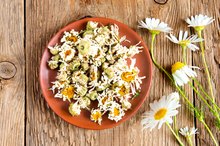Herbal Alternatives to Hydrocodone
Hydrocodone is a prescription painkiller from the opiate family. It works by attaching to opiate receptors in the brain, resulting in a decrease in pain perception. Hydrocodone is prescribed to relieve mild to moderate pain associated with conditions including arthritis, back pain and physical injury. There are a number of herbal alternatives to hydrocodone. Some produce painkilling effects closely comparable to the drug.
Kratom
Kratom (Mitragyna speciosa) is hydrocodone's closest herbal relative. It has been used in Asian countries for centuries for its ability to decrease pain and fatigue, allowing workers to continue in spite of discomfort. In small doses, it produces stimulating effects. Larger doses can lead to sedation.
While not an opiate itself, kratom is a mu-opioid agonist that affects the same brain receptors as opiates such as hydrocodone. Effects include increased pain tolerance, improved mood and feelings of intoxication.
Like hydrocodone, kratom has the potential to cause addiction and withdrawal. According to Erowid, peasant workers in Asia frequently become addicted to the herb and suffer withdrawal upon cessation. Kratom is illegal in Thailand and many other nations but is not currently scheduled in the U.S. Those who choose to use kratom should do so with extreme caution and only under a doctor's supervision.
- Kratom (Mitragyna speciosa) is hydrocodone's closest herbal relative.
- Like hydrocodone, kratom has the potential to cause addiction and withdrawal.
Willow Bark
Tiger Balm Ingredients
Learn More
Willow bark is among the most popular and effective anti-inflammatory herbs. It contains salicylin, the same active compound as aspirin (salicylic acid). According to the National Institutes of Health, willow bark is superior to placebo in relieving the pain of osteoarthritis and is well tolerated by most patients. It may also be useful for treating other types of inflammatory pain, such as that associated with minor injury, toothache, menstrual cramps and burns or cuts.
Like aspirin, willow bark may increase the risk for stomach bleeding, especially when taken with NSAID pain relievers such as ibuprofen or naproxen.
- Willow bark is among the most popular and effective anti-inflammatory herbs.
- According to the National Institutes of Health, willow bark is superior to placebo in relieving the pain of osteoarthritis and is well tolerated by most patients.
Cayenne
Known more for its hot and spicy flavor than its painkilling ability, cayenne pepper is sometimes used to treat joint pain in patients with certain types of arthritis. It contains capsaicin, which acts as a counterirritant when applied to the skin and distracts the brain from underlying pain.
When taken internally, cayenne causes a burning sensation in the mouth, which triggers the release of endorphins in the brain. Endorphins are naturally occurring chemicals that produce effects similar to those of hydrocodone and other opiates, including improved mood and increased pain tolerance.
- Known more for its hot and spicy flavor than its painkilling ability, cayenne pepper is sometimes used to treat joint pain in patients with certain types of arthritis.
- When taken internally, cayenne causes a burning sensation in the mouth, which triggers the release of endorphins in the brain.
Valerian Root
List of Opiate Prescriptions
Learn More
Sometimes referred to as “nature’s Valium,” valerian root is a wildly popular herbal supplement in the U.S. It's native to Europe but grows freely in many parts of the world and has been used traditionally to treat everything from nervousness to epilepsy.
The active compound in valerian root is valerenic acid, which affects the same neurotransmitters as benzodiazepines like diazepam (Valium). In addition to its calming effects, valerian root is a mild muscle relaxant and may reduce spasms that cause certain types of pain. According to Medline Plus, valerian root can be used to treat the pain of menstrual cramps, angina, nerve pain and rheumatic pain, though evidence for its effectiveness is inconclusive.
- Sometimes referred to as “nature’s Valium,” valerian root is a wildly popular herbal supplement in the U.S.
- It's native to Europe but grows freely in many parts of the world and has been used traditionally to treat everything from nervousness to epilepsy.
- In addition to its calming effects, valerian root is a mild muscle relaxant and may reduce spasms that cause certain types of pain.
Related Articles
References
- Erowid: A Study of Kratom Eaters in Thailand
- National Institutes of Health: Efficacy and tolerability of a standardized willow bark extract in patients with osteoarthritis: randomized placebo-controlled, double blind clinical trial
- U.S. Food and Drug Administration (FDA). Statement from FDA commissioner Scott Gottlieb, M.D., on the agency's scientific evidence on the presence of opioid compounds in kratom, underscoring its potential for abuse. Published February 6, 2018.
- Singh D, Müller CP, Vicknasingam BK. Kratom (Mitragyna speciosa) dependence, withdrawal symptoms and craving in regular users. Drug Alcohol Depend. 2014;139:132-7.
- Vicknasingam B., Narayanan S., Beng GT., Mansor SM. The informal use of ketum (Mitragyna speciosa) for opioid withdrawal in the northern states of peninsular Malaysia and implications for drug substitution therapy. International Journal of Drug Policy. 2010;21(4):283-8. doi:10.1016/j.drugpo.2009.12.003
- Singh D, Müller CP, Vicknasingam BK. Kratom (Mitragyna speciosa) dependence, withdrawal symptoms and craving in regular users. Drug Alcohol Depend. 2014;139:132-137. doi:10.1016/j.drugalcdep.2014.03.017
- Váradi A., Marrone GF., Palmer TC., et al. Mitragynine/corynantheidine pseudoindoxyls as opioid analgesics with mu agonism and delta antagonism, which do not recruit β-arrestin-2. Journal of Medicinal Chemistry. 2016 22;59(18):8381-97. doi:10.1021/acs.jmedchem.6b00748
- White CM. Pharmacologic and clinical assessment of kratom: An update. Am J Health Syst Pharm. 2019;76(23):1915-1925. doi:10.1093/ajhp/zxz221
- Drug Enforcement Administration. Schedules of controlled substances: temporary placement of mitragynine and 7-hydroxymitragynine into schedule I. Published August 31, 2016.
- Drug Enforcement Administration. Withdrawal of notice of intent to temporarily place mitragynine and 7-hydroxymitraginine into schedule I. Published October 13, 2016.
- U.S. Food and Drug Administration. Statement from FDA commissioner Scott Gottlieb, M.D. on FDA advisory about deadly risks associated with kratom. Updated April 5, 2018.
- Swetlitz I. HHS recommended that the DEA make kratom a Schedule I drug, like LSD or heroin. STAT. Published November 9, 2018.
- U.S. Food and Drug Administration (FDA). FDA issues warning to companies selling illegal, unapproved kratom drug products marketed for opioid cessation, pain treatment and other medical uses. Updated June 25, 2019.
- NIDA. Kratom DrugFacts. National Institute on Drug Abuse website. Updated April 8, 2019.
- Drug Enforcement Administration. Kratom. Published April 2020.
- Adkins JE., Boyer EW., McCurdy CR. Mitragyna speciosa, a psychoactive tree from southeast asia with opioid activity. Current Topics in Medicinal Chemistry. 2011;11(9):1165-75. doi:10.2174/156802611795371305
- National Institute on Drug Abuse. What Is Kratom?
- Prozialeck WC., Jivan JK/, Andurkar SV. Pharmacology of kratom: an emerging botanical agent with stimulant, analgesic, and opioid-like effects. Journal of the American Osteopathic Association. 2012;112(12):792-9.
- Váradi A., Marrone GF., Palmer TC., et al. Mitragynine/corynantheidine pseudoindoxyls as opioid analgesics with mu agonism and delta antagonism, which do not recruit β-arrestin-2. Journal of Medicinal Chemistry. 2016 22;59(18):8381-97. doi:10.1021/acs.jmedchem.6b00748.
- Vicknasingam B., Narayanan S., Beng GT., Mansor SM. The Informal Use of Ketum (Mitragyna Speciosa) for Opioid Withdrawal in the Northern States of Peninsular Malaysia and Implications for Drug Substitution Therapy. International Journal of Drug Policy. 2010;21(4):283-8. doi:10.1016/j.drugpo.2009.12.003.
Resources
Writer Bio
Based in Las Vegas, Tracii Hanes is a freelance writer specializing in health and psychology with over seven years of professional experience. She got her start as a news reporter and has since focused exclusively on freelance writing, contributing to websites like Wellsphere, Education Portal and more. She holds a Bachelor of Arts in communication arts from Southwestern Oklahoma State University.









